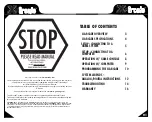
Planning the electrical installation
32
3ADW000462R0301 DCS880 Hardware Manual e c
Conclusion for the field circuit
Basically, similar conditions apply for both field and armature circuit. Depending on the converter
used (half-controlled bridge, fully controlled bridge), some of the fault sources may not always be
applicable. Due to special system conditions, such as supply via an autotransformer or an isolating
transformer, new protection conditions may occur.
The following configurations are very often used:
In contrast to the armature circuit, fuses are
never
used on the DC side of the field circuit, since a
fuse trip might lead to additional damage e.g. small, but long-lasting overcurrent, contact problems,
explosions, fires, etc.
Semiconductor fuses F3.1 (super-fast acting) should be used, in case of similar conditions compared
to the armature circuit (4-Q operation). E.g. protection of the field circuit and the field winding.
Configuration for field circuit
Fuses F3.2 and F3.3 are used as line protectors and
cannot protect the field supply
unit. Only pure
HRC fuses or miniature circuit-breakers must be used. Semiconductor fuses will be tripped, for
example, by the transformer’s inrush current.
Configurations for field circuit
Semiconductor fuses (F1) and fuse holders for armature circuit
The converters are subdivided into two groups:
- Unit sizes H1, H2, H3 and H4 with rated currents up to 1000 A require external fuses.
- In unit sizes H5, H6, H7 and H8 with rated currents from 900 A to 5200 A, branch fuses are
internally installed (no additional external AC or DC fuses are needed).
The fourth column of the table below assigns the AC fuse to the unit. In case the converter should be
equipped with DC fuses, use the same type of fuse as on the AC side.
2
F
3
.1
SB_SIC_001_a.ai
ND
3
0 /
built-in
F
3
.
3
2
2
F
3
.2
F
3
.1
F
3
.1
SB_SIC_001_a.ai
ND
3
0 /
built-in
















































